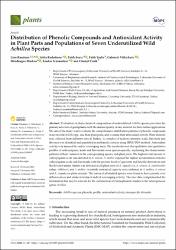Distribution of phenolic compounds and antioxidant activity in plant parts and populations of seven underutilized wild achillea species

View/
Access
info:eu-repo/semantics/openAccessDate
2022Author
Raudone, LinaRadusiene, Jolita
Seyis, Fatih
Yayla, Fatih
Vilkickyte, Gabriele
Marksa, Mindaugas
Ivanauskas, Liudas
Çırak, Cüneyt
Metadata
Show full item recordCitation
Raudone, L., Radušiene, J., Seyis, F., Yayla, F., Vilkickyte, G., Marksa, M., Ivanauskas, L., & Cırak, C. (2022). Distribution of Phenolic Compounds and Antioxidant Activity in Plant Parts and Populations of Seven Underutilized Wild Achillea Species. Plants (Basel, Switzerland), 11(3), 447. https://doi.org/10.3390/plants11030447Abstract
Evaluation of phytochemical composition of underutilized Achillea species provides the primary selection of germplasms with the desired quality of raw material for their further applications. The aim of the study was to evaluate the comprehensive distribution patterns of phenolic compounds in seven wild Achillea spp. and their plant parts, and to assess their antioxidant activity. Plant material was collected from different sites in Turkey. A complex of hydroxycinnamic acids, flavonols and flavones was identified and quantified in methanolic extracts using HPLC-PDA method. Antioxidant activity was assessed by radical scavenging assay. The results showed that qualitative and qualitative profiles of caffeoylquinic acids and flavonoids were species-specific, explaining the characteristic patterns of their variation in the corresponding species and plant parts. The highest total amount of caffeoylquinic acids was detected in A. setacea. A. arabica exposed the highest accumulation of mono-caffeoylquinic acids and flavonoids with the greatest levels of quercetin and luteolin derivatives and the flavonol santin. Santin was detected in all plant parts of A. cappadocica, A. setacea, A. santolinoides subsp. wilhelmsii, and A. arabica. A notable antiradical capacity was confirmed in A. arabica, A. setacea and A. cappadocica plant extracts. The leaves of all studied species were found to have priority over inflorescences and stems in terms of radical scavenging activity. The new data complemented the information that may be relevant for the continuation of chemophenetic studies in the heterogeneous genus Achillea.

















